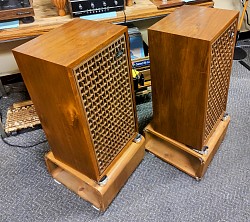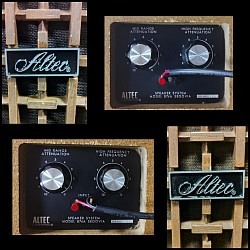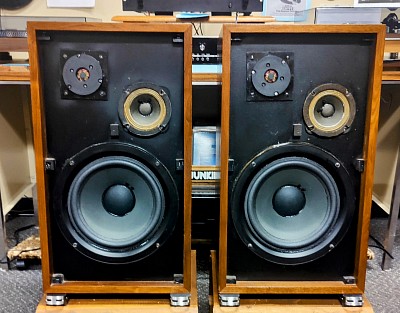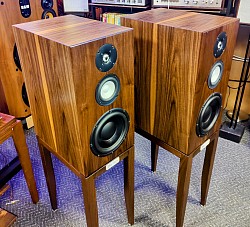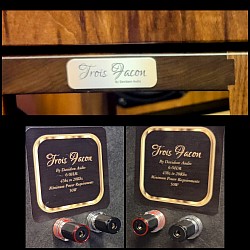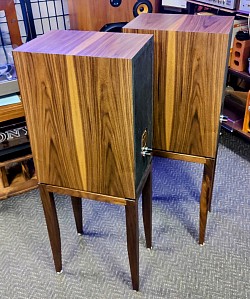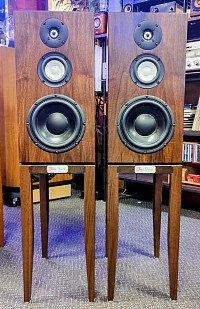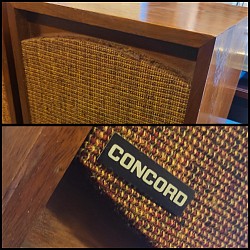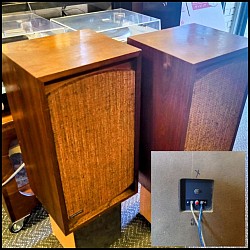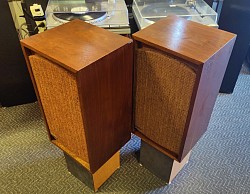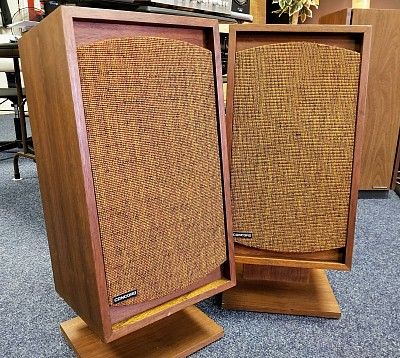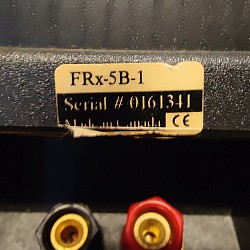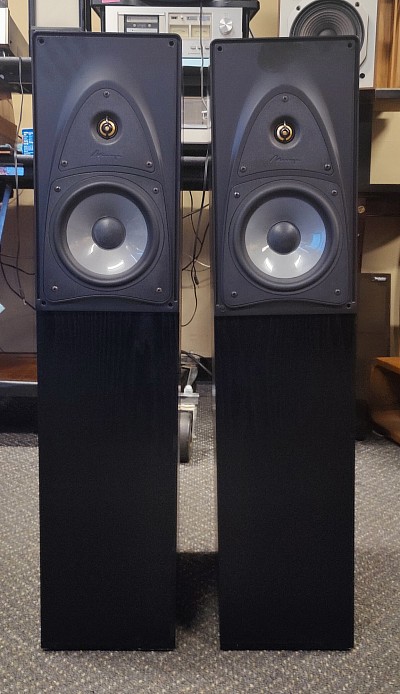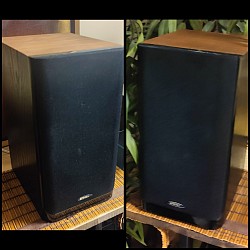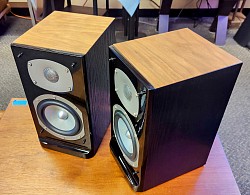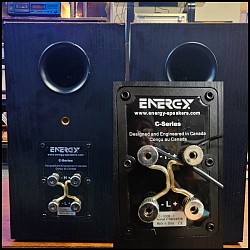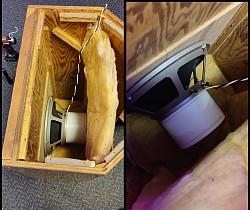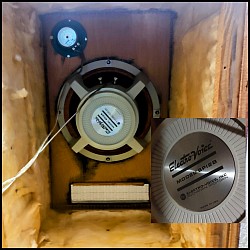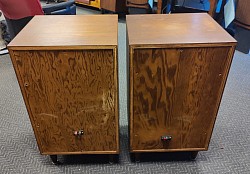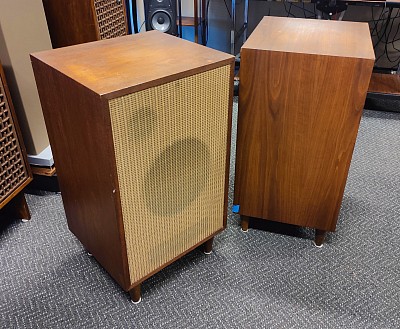Page 1 Stereo Speaker Systems
Altec Lansing Segovia 874A
('71-'76) $600 (Xlnt, refoamed)
In very good cosmetic condition, 100% original and fully operational, this pair of the much heralded Altec Lansing Segovia 874A speakers are a vintage throwback to the "good old days" of fine loudspeaker design.
In this 3-way system, (rated at 4 ohms) the original (refoamed) proprietary woofers have 10" cones (in 12" frames) with stepdown rings, 20 lb alnico magnets and flat wire wound voice coils.
To complete the trifecta, they have 4" mids and proprietary dome tweeters.
The authentic American walnut enclosures are in fine shape; there are no battle scars as are often seen on cabinets nearly 50 years old. The unique, lattice-style wooden grills are beautiful, they catch your eyes immediately; they scream "vintage"!
( "You can't rush good furniture making. Selecting woods, matching grains, milling pieces, bonding, bracing, sanding, finishing, re-sanding, inspecting, and more sanding and hand-rubbing all take patience and time." This was the attitude of the more than 40 skilled craftsmen at Hill-Craft Mfg. Company, they were the cabinet makers who made all of the speaker cabinets and ensembles for Altec.)
The Segovia was their top-of-the-line oversized bookshelf speaker. It was a great-sounding speaker back then and still sounds wonderful today. The Segovia features all direct radiators (drivers) and they are also very sensitive. They are not horn loaded, but still very efficient.For size and sonic comparison, they are the same size and basic configuration as JBL L100, but way more neutral plus they have sealed enclosures as opposed to JBL's ported ones. The woofers crossover at a sensible 500Hz while the L100 crossover was at 1500, which is really high for a 12" driver. Altec smartly used a near full-range 4" midrange in this speaker, covering the entire midrange.
Online comments:
"One thing real neat about the Segovia 874A is the 12" woofer was used exclusively in the Segovia, the magnet is just massive with an impressive extruded type basket design. They operate in the 4 ohm range and have some decent cabinet weight to them. Inside you should find the original insulation" (yes, it's there!)
"I have a pair, and they play all types of music well. Live music, to me, is exceptional. The high and mid attenuators help with room acoustics." (agree!)
"Have used mine with my Scott 299C and they worked / sounded great. 299c and LK72 are basically the same amp. I actually thought they sounded better hooked up to the 8 ohm taps, though. Currently my Segovias are powered by my Dynaco ST35, again with the 8 ohm taps. Both combinations are really, really good! You will have no problems enjoying them"
From Altec's 1971 catalog:
"The new 3-way Segovia incorporates all the exclusive Dynamic Force design concepts which are featured in the Barcelona, Granada and Santiago speaker systems. Housed in a contemporary cabinet with an attractive fretwork grille, is a completely new 12-inch Dynamic Force woofer capable of producing an extended low frequency range with very low distortion characteristics. The popular Altec 405A 4-inch speaker provides a smooth mid frequency response with wide dispersion characteristics. The high frequency tweeter is a high quality dome radiator with excellent dispersion and virtually flat response to 20,000 Hz. The dividing networks are a full 12 dB per octave filters at 500 Hz and 4,000 Hz. mid-range and high frequency attenuator controls are provided on the rear of the enclosure.
Basic specs:
Frequency Response: 20-20,000 Hz
Power Rating: 60 watts
Impedance: 4 ohms
Crossover Frequency: 500-4,000 Hz
Dimensions: 25"H x 14.5"W x 12"D
Weight: 50 lbs each
About Altec Lansing...
Altec Lansing was an American based electronics company founded in 1927. Their primary products are speakers and associated audio electronics for professional, home, automotive and multimedia applications.
Engineers at Western Electric who later formed Altec Services Company, developed the technology for motion picture sound that was introduced in 1927 with the release of The Jazz Singer. For the best information about this famous company, here is a great link that tells the real story:
http://www.audioheritage.org/html/history/altec/altec-1963.htm
++++++++++++++++++++++++++++++++++++++++++
++++++++++++++++++++++++++++++++++++++++++
Trois Facon by Davidson Audio
(2024) SOLD
Available in either American Walnut or Cherry
As the exclusive dealer rep for *Davidson Audio we are pleased to announce their latest creation...Trois Facon (French for "three ways" pronounced "traw-fa-cone").
*NOTE: The boutique artisans at Davidson Audio have previously created and designed the Bel Suono, Febrero, Ottobre, Froy, Augustus and other models over the years. Those who decide to buy any of Davidson Audio's designs can rest assured they will own exclusive, "one-off" custom designs hand-built by a master craftsman with many years of teaching and building unique speaker systems. Mr Davidson is always available for personal contact regarding any questions about his designs.
Each of the 46 lb enclosures measures 21" tall x 11.25" wide x 16" deep.
When placed on the matching stands, they are 42" tall. They have a nominal impedance of 6 ohms. The cabinets have your choose of either luxurious American Walnut veneer or Cherry.
*NOTE: as of 7/27 the Trois Facon with cherry finish is sold and no longer available.
John Davidson describes the Trois Facon:
"The Trois Facon is my second 3-way design. My last two designs (Bel Suono and Augustus) focused on using top-of-the-line drivers and, as a result, proved to be more costly than expected. Even though I've never been (and probably will never be) profit motivated when it comes to building speakers, I usually end up with a final price that's related to build costs.
Having said that, it's probably more than likely a lot of people are not comfortable paying over $2000 for a pair of speakers. So, the focus for the Trois Facon was to build the best speaker I can with moderately priced drivers and, ultimately, reduce the cost.
The bass driver I selected for the speaker is the Peerless SLS-830667. This driver has been around for many years and has a reputation for value and performance. Also, this woofer is optimized for use in a sealed box, easily reaching the F3 roll off at 45Hz. But in addition to this, sealed woofers have a gentler roll off than ported boxes giving this design usable bass below 40Hz. The Peerless woofer also has a great flat extension up to 1Khz.
The midrange driver is a SB Acoustics 4-inch ceramic cone drive with a beautiful flat response through the midrange frequencies. The driver starts to roll off at about 3 Khz and has no breakup until about 7 Khz, well past the intended crossover point.
The tweeter also comes from SB Acoustics. This 1" ceramic dome tweeter has a ruler flat response from 800Hz to over 30 Khz. The ceramic dome is very stiff pushing any breakup mode well past the audible range. This tweeter is easy to listen for without any fatiguing characteristics.
The cabinet is constructed out of ¾” MDF on all sides except the front baffle. The baffle is constructed from 1” MDF and the cape with ½” piece of solid American walnut or Cherry.
An internal enclosure is also constructed inside the box to isolate the midrange from the woofer. The box is also integrated into the cabinet to provide bracing on the tall side of the cabinet. The sides and top of the cabinets are covered in thick walnut veneer to match the baffle.
I also built a pair of very sturdy, matching wood finish stands. These stands are so strong they easily support the 46 lb. cabinets.
This combination gives this system a sleek and elegant look.
The crossovers are constructed using air core inductors, and polycaps. No electrolytic capacitors are used in the crossovers. I use a combination of 1st order; 2nd order and 3rd order filters to take advantage of the wide power bands and natural roll offs of each of the drivers. This provides a seamless transition between the drivers. The crossovers frequencies are 650Hz and 3Khz. Overall, this is one of the smoothest speaker systems I have ever built and I will miss them. I have enjoyed them so much I am finding it difficult to hand them off to my Cherry Vintage Audio in Greenville SC (since 2019, they are the exclusive dealer handling my designs.)
The speaker has a sensitivity of about 87dB per 2.83V. The impedance never goes below 6.5 ohms and stays at 8 ohms or more for 90% of its frequency range. It is an easy speaker to drive. It does well with any amp or receiver of about 50 watts. Max power is about 100 watts but as always, any time the speaker starts to sound stressed you need to turn down the volume. I personally was using a 300-watt amp.
About Davidson Audio...
Based in Easley SC, John Davidson has over 25 years experience in custom loudspeaker design and technology. During the late 60's, at the tender age of 12 and through the teen years, the addiction to HiFi led to a serious study of electronics. For his senior high school project he built his first amplifier. Eventually he earned a degree in electronic engineering technologies and began to work in the industrial manufacturing area. All the while, the HiFi bug continued as a serious hobby. Today, his designs can be seen and heard exclusively at Cherry Vintage Audio in Greenville, SC
In the mid '90s, with the consent and encouragement from wife and family, he decided to build a high quality media room at home. After setting a substantial budget for the intended gear, he discovered, very quickly, just how little the speaker budget had actually brought to the table. This led to researching the REAL cost in manufacturing high quality speakers which, in turn, led him to the surprisingly abundant world of DIY. From that point on he never purchased a new set of commercially built speakers.
With his substantial and continuing understanding of electronics and the benefits of his other serious hobby, woodworking, he set out to build his own speakers. By intensive reading and studying (along with trial and error), he gained the understanding and formulas of speaker construction. Over the next 25 years he built many sets of speakers of his own design along with some from other designers he had come to respect.
As he states "my designs typically start by combing through hundreds of data sheets from driver manufactures to find specific drivers that fit the acoustic and electrical characteristics I want. Using that reference data, I make base calculations on the crossovers. However, since drivers are a type of motor and dynamic by nature, the static calculations serve only as a starting point. It is impossible to produce a design with just base static calculations that will be pleasing to the ear. So next comes the most difficult and time consuming aspect of any new design: hours, days, weeks, and even months of listening, testing and tweaking the crossover to produce the desired final product. Once the crossover is worked out the woodworking starts. Selecting the best materials, I construct the cabinets. I use proven construction techniques and try to add visual interest using contrasting solid woods and veneers. Internal bracing adds rigidity and lining the enclosures with acoustic foam eliminates standing waves and distortion. In the end, the enclosure must be functional but also pleasing in cosmetic design. My philosophy towards loudspeaker design begins with the realization that it's an artful process that's based in science and engineering. The final tuning of the crossover by ear combined with the design and construction of the enclosure is what elevates a loudspeaker into something you never tire of listening to."
++++++++++++++++++++++++++++++++++++++++++
++++++++++++++++++++++++++++++++++++++++++
Concord CE-2W
(1978) SOLD
This pair of Concord CE-2W are a stunning pair of very rare and collectible, vintage 2-way speakers with absolutely beautiful, terracotta fabric grills fashioned over arched frames.
The solid hardwood cabinets have real walnut veneer and are in excellent condition. Typical of the Epicure sound, the CE-2W are rated at 8 ohms and are a 2-way with 10" woofers and 2" tweeters. Unlike Epicure, these are front ported for clean bass. The rear attenuators function perfectly to trim the high frequency to suit the room environment.
We have to admit, every once in a while, truly rare and beautiful things show up that completely and accurately define "vintage audio".
About Concord/Epicure...
Epicure, a well known name in vintage speaker lore, was a USA-based loudspeaker manufacturer founded in 1970 by Winslow Burhoe. They made a very popular series of relatively inexpensive loudspeakers. In the 80's the company introduced a line of speakers branded as Epicure that where very popular with the US audio press, the company actually changed it's name to Epicure Products, Inc. in 1977.
Shortly thereafter, around 1978, Epicure was purchased by the Japanese manufacturing subsidiary of Concord Electronics. Concord was originally located in Los Angeles during the late 60's and 70's and were known fpr producing very good reel-to-reel tape decks, receivers and car stereos. For a few short years, Concord/Epicure produced a line of speakers that are now considered highly collectible, very rare and very unique in design and appearance.
They, in turn, eventually sold the company to Harman International in or around 1987 and that company did for a time manufacture speakers under the EPI name but these are believed to have been made by other Harman owned concerns.
Finally, Concord was sold off along with Epicure in 1986 and they faded away into history. Although the name "Concord" has been, and continues to be, used by many companies for many different products, there was only one Concord/Epicure as far as we know.
+++++++++++++++++++++++++++++++++++++++++
+++++++++++++++++++++++++++++++++++++++++
Mirage FRx-5
(Canada, 1999) $275
In very good cosmetic condition and fully operational, this pair of Canadian-made Mirage FRx 5 tower (floorstanding) speakers definitely punch higher than their class.
The FRx-5 is a two-way design, the tweeters are .75" metal hybrid domes and the 6.5" bass/mid drivers have poly cones with rubber surrounds. The 2" bass ports on the rear will yield the type of bass you prefer by settling on the distance to the rear wall of your listening room.The nominal impedance is 8 ohms and they are able to handle 200 watts each with an efficiency of 90dB.
The well braced, black oak veneer cabinets measure 33"H x 7.5" W x 12"D. At about 32 lbs each, they are solidly built and have such a satisfying bottom end that a subwoofer is certainly not necessary.
About Mirage...
Back in the day, there was a company in Canada, called Inception Audio at that time, importing Tangent product from England. They had done a really great job of importing, to the extent that Tangent couldn't keep up production, got in over its head, and was about ready to go out of business due both to their success, ironically, in the Canadian market, and to poor management. About that time KEF suddenly went out of the OEM driver market and Tangent had been using KEF drivers. Suddenly, Inception couldn't get product...so in a crash design situation—in about a month—they did the whole original Mirage line, with available Audax drivers that were quite similar, actually, to the KEFs. The rest, as they say...is history.
++++++++++++++++++++++++++++++++++++++++
++++++++++++++++++++++++++++++++++++++++
Energy C-100
('09-'11)
Obtained locally from the original owner, this pair of Energy C-100 bookshelf speakers are in excellent cosmetic and operating condition. Each enclosure features a 5.5" fiberglass woofer and a flat on-axis frequency response with a wide bandwidth that makes the sound smooth and clean.
From the factory data sheet:
~Strong, deep bass from a 5.5" fiberglass woofer
~Clean, accurate highs from the 1" chambered aluminum dome tweeter
Flat On-Axis Frequency Response with Wide Bandwidth: Speakers should reproduce the entire audio range in a uniform manner.
~While no speaker system is distortion- or resonance-free, Energy has achieved a significantly lower distortion level, a clearly audible improvement Rear venting for more powerful bass response
Specs:
System Type: Bass Reflex, Rear Vented
Frequency Response: 55Hz-20kHz +/- 3 dB
Recommended Amplifier Power: up to 110 watts
Components: Chambered 1” Aluminum Dome,
5-1/2” Composite Fiberglas cone
Impedance: 8 ohms nominal; 4 ohms minimum
Useable Bass Response (10db Anechoic): 50 Hz
Sensitivity: 90dB
Dimensions: 6.75”W x 11.5”H x 8.5”
Weight: 11lbs each
About Energy...
Currently owned and operated by the Klipsch Group inc., Energy has been a leader in audio research and development as well as in the engineering and manufacturing of speakers since 1973. They took what they learned from their involvement with some of the earliest Canadian studies on psychoacoustics, and proceeded to achieve pure, accurate sound reproduction in all their Energy speakers through three vital performance principles: flat on-axis frequency response with wide bandwidth; wide, constant dispersion; and low distortion and resonance.
Worldwide Distribution
Klipsch Group, Inc. oversees business operations for the Energy®, Mirage®, Klipsch® and Jamo® speaker brands and distribution companies worldwide. This technology powerhouse is focused on leveraging its highly acclaimed product lines to offer a unique and powerful single supply source for its retailers, distributors and contractors globally.
+++++++++++++++++++++++++++++++++++++++++
+++++++++++++++++++++++++++++++++++++++++
Electro Voice SRO/15 custom
(late 50's / early 60's) Sold
This pair of custom-built cabinets contain excellent (original, fully working) Electro Voice drivers and Bozak crossover systems. The professionally designed boxes have finished frames with authentic cane weave grills.
They need to be seen and heard, photos and description does not do them justice!
Each of the laminated maple finished bottom cabinets is roughly 3.2 cu.ft. with a shelf port on the bottom divided into 3 sections.
(the frame is designed for the SRO/15 woofer to be attached to the baffle from inside the cabinet)
The smaller matching laminated maple cabinet with the EV-TC35 tweeter, TC8 midrange and Bozak N104 crossover sits on top.
The wiring is extremely simple.
The front grill frames are made of stained real maple.
Crossover:
Crossover: Bozak N-104 LC 3-way, 8 ohms network (1958)
Crossover frequencies: 400Hz, 2.5kHz.
Crossover slopes: 6dB/octave, first-order.
Frequency range: 28Hz–20kHz.
Drivers: Electro Voice SRO/15 woofer
Electro Voice TC-35 tweeter
Electro Voice TC-8 midrange
Basic specs:
Nominal impedance: 8 ohms.
Power requirements: 60 watts max
Dimensions: 39"H x 19.5"W x 15"D
Weight: Top: 15 lbs / Bottom: 60 lbs
Electro Voice SP-12B /
custom design (late 70's) Sold
In excellent cosmetic condition and fully operational, this pair of custom built cabinets each features a single 12" Electro Voice SP-12B woofer and single 1" cone tweeter. They also feature beautiful fine cabinetry and the original factory cane weave grills.
The main drivers in both of the enclosures are the EV-SP12B woofers which was in the same family as the 12TRXB coaxial driver used in the legendary EV "Aristocrat" model first introduced in 1957. This driver was also used in TQWT, bass reflex, horn enclosures or open baffle cabinets. They are rated at 95dB efficient and 16 ohms nominal impedance. That means they would be perfect with low power tube amps.
This cabinet design most closely resembles the Rebel/Shorthorn concept PWK hatched. EV introduced the dual slits first in the Empires and named them Bilinear Lenticular Slots and marketed "BLS".The Electro-Voice SP-12B was primarily produced between the late 70's and early 90's. However, specific model variations might have been available for a slightly longer period depending on the market and production runs.
Key points about the Electro-Voice SP-12B:
Popular model: It was considered a high-quality, professional-grade speaker used in various live sound applications, including concerts and large events.
Design features: The design offers a wide frequency response and powerful sound projection.
Production shift: As technology advanced, Electro-Voice introduced newer speaker models, leading to the gradual phasing out of ceratin units.
Basic specs:
Dimensions: 16"D x 18"W x 32"H
Weight: approx 40 lbs each
About Electro-Voice...
In 1927, Al Kahn and Lou Burroughs established the company Radio Engineers in the basement of the Century Tire and Rubber Company in South Bend, Indiana. At this site they first began producing microphones to use in their PA systems, and later to sell to people who couldn’t but them any other way. Incorporated on July 1, 1930, Electro-Voice was involved heavily in installation and rental of public address systems for churches and other public buildings. Politicians especially had become aware of the power of the microphone to increase their reach, and demanded ever more powerful PA systems. Microphones were originally manufactured only for EV’s own use, but within a few years the balance had shifted and manufacturing microphones for sale to others had become the more important part of the business. Thus, the EV branded microphones were used by most of the professional recording studios at one time. They moved into loudspeaker production as a natural progression of the audio market.
Ultimately, Electro-Voice speakers were THE super efficient speakers of the 60's and early 70's and many well known companies like Klipsch used them in their larger models.
+++++++++++++++++++++++++++++++++++++++++++++++++++
+++++++++++++++++++++++++++++++++++++++++++++++++++
Technics SB-X10
('78-'79) SOLD
Obtained from the original owner and in very good condition, this pair of *Linear Phase Technics SB-X10 is a two-way system from the late 70's
Each of the walnut veneer cabinets contains:
~single 8" woofer (with treated cloth inverted surrounds) featuring a wide frequency response up to 5Khz to retain smooth crossover at 3Khz.
It also has a heat-resistant voice coil.
~single 1"soft dome tweeter with aluminium bobbin, polyamide adhesive, polyester insulation layer, thermal protection relay and 13,500G magnet.
The SB-X10 was part of the second generation of Technics' Linear Phase loudspeakers, in more discrete shapes than the big *SB-7000.
The tweeter is naturally recessed in comparison to the slightly protruding woofer.
Thermal relays for each driver are placed at the input point of the speaker coils set in as soon as excessive heat builds up caused by amplifier clipping ; The reset buttons are located at the back, just above the terminals.
SB-X10 was named SB-X1 in Japan, with differences in crossover frequencies and part of the specifications.
Japan also had a tiny & cute SB-X01 added to the lineup.
Not ultra high-end but very well made bookshelf loudspeakers with clean and straight sound.
*About Technics' linear phase...
Although the Japanese dominated much of the hi-fi scene during the 1970s, there was one important area where their reach was more limited. That was the loudspeaker market. Yes, the companies' catalogs may have been full of glittering arrays of tempting models, but dealers outside of Japan seldom had that many in stock for interested buyers either to see or hear.
One vintage Japanese loudspeaker with which everyone is familiar is the Yamaha NS-1000M [HFN Oct '18], but what is less well known is that all the big Japanese brands offered something of a similar size, cost and ambition (if not absolute quality). It was inevitable then, that Matsushita – then the world's largest maker of electronic consumer products – would offer a series of linear phase high-quality loudspeakers under its Technics brand. This series reached the wider market around 1977. As with much Japanese kit, the famous SB-7000 offered a headline refinement to set it apart from competitors: 'phase linearity'.
Linear phase loudspeakers were not new and had been available for professional use since the mid '60s. But the Technics' designs (on their bigger models) were based on complex set-ups involving active crossovers and multiple amp channels.
+++++++++++++++++++++++++++++++++++++++
+++++++++++++++++++++++++++++++++++++++
